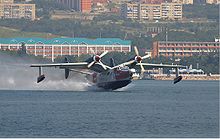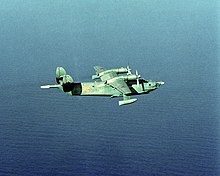Beriev Be-12
| Beriev Be-12 | |
|---|---|
 Beriev Be-12PS (2011) |
|
| Type: | Amphibious flying boat |
| Design country: | |
| Manufacturer: |
Beriev |
| First flight: |
1960 |
| Production time: |
1964 - |
| Number of pieces: |
~ 150 |
The Beriev Be-12 Chaika ( seagull , Russian Бериев Бе-12 Чайка , NATO code name : Mail ) is a large military amphibious flying boat that can take off and land on water and also has a retractable landing gear for take-offs and landings on solid ground. It was developed as a maritime scout for sea and coastal surveillance, for the search for mineral resources, for submarine hunting and for sea rescue .
history
The Be-12 first flew around 1960 and was shown to the public a year later at the air parade in Moscow-Tushino . From the second half of the 1960s, it was incorporated into the Soviet naval forces and replaced the Be-6 . A visual feature is the long MAD stern spike, which was used to locate submerged submarines . A total of around 150 machines were built. In the Central Museum of the Air Force of the Russian Federation in Monino one can Be-12 be visited.
From October 23 to 27, 1964, a Be-12 with a crew under M. Michailow set a total of six world altitude records with different payloads.
After the dissolution of the Soviet Union, some aircraft were converted to fire-fighting aircraft Be-12P. Plans for this had existed under the designation Be-18 since the 1960s. Four former naval aircraft were converted in this way in the first half of the 1990s. The military equipment was removed, except for the radar, and replaced by a total of 6 m³ water tanks in the hull. The water absorption takes place on the water sliding in 25 to 30 seconds, but can also be carried out on land. The first of these machines ("Yellow 40", factory number 9601504) completed its maiden flight on April 27, 1992 in Taganrog. By the year 2000 alone, these Be-12s dropped 17,188 tons of water in forest fires in the entire Russian area. On July 14, 1993, the Yellow 40 was lost in an operation. Another converted machine with the serial number 8601301 (registration number RA-00046) flew for the first time on August 9, 1996 under the designation Be-12P-200. Thanks to a modernized system, it is now able to absorb water in just 20 seconds.
User states
Current users
-
 Russia - As of January 2018, 4 Be-12s are in service with the naval war fleet .
Russia - As of January 2018, 4 Be-12s are in service with the naval war fleet . -
 Ukraine - As of January 2018, the naval forces have 2 Be-12s, but these are not considered operational.
Ukraine - As of January 2018, the naval forces have 2 Be-12s, but these are not considered operational.
Former users
-
 Soviet Union - After the dissolution, the remaining aircraft of the naval forces were distributed to the successor states.
Soviet Union - After the dissolution, the remaining aircraft of the naval forces were distributed to the successor states. -
 Syria - Retired from the air force by January 2018 at the latest .
Syria - Retired from the air force by January 2018 at the latest . -
 Vietnam - Retired from the air force by January 2018 at the latest .
Vietnam - Retired from the air force by January 2018 at the latest .
Technical specifications
| Parameter | Data |
|---|---|
| Wingspan | 29.71 m |
| length | 30.17 m |
| height | 7.0 m |
| Wing area | 105 m² |
| Empty mass | 19,500 kg |
| Takeoff mass | Max. 29,500 kg |
| Engine | two propeller turbines Ivchenko AI-20D |
| power | 3,125 kW each (4,190 WPS) |
| Top speed | 610 km / h at an altitude of 3,050 m |
| Marching speed | 547 km / h at an altitude of 4,570 m |
| Patrol speed | 320 km / h at a height of 300 m |
| Range | 4,000 km |
| Armament | up to 5,000 kg in the fuselage shaft and on the wings (target-seeking torpedoes, depth charges, mines, rockets, bombs ( sonar buoys are stored in the stern)) |
literature
- Nikolaus Krivinyi: Taschenbuch der Luftflotten 1976 . J. F. Lehmanns, Munich 1976, ISBN 3-469-00511-7 .
- The International Institute for Strategic Studies (IISS): The Military Balance 2018 . 1st edition. Routledge, London 2018, ISBN 978-1-85743-955-7 (English, January 2018).
Web links
- Aeroflight: Beriev Be-12 'Mail'
Individual evidence
- ^ Karl-Heinz Eyermann , Wolfgang Sellenthin: The military aviation of the USSR. Central Board of the Society for German-Soviet Friendship, 1967, p. 42.
- ↑ Erich Strobl, Francois Nôtre, Ulrich Unger: Europe's flying fire brigades - The Be-12P water bomber. In: Flieger Revue Extra No. 9, Möller, 2005, ISSN 0941-889X , p. 99.
- ↑ a b c d The International Institute for Strategic Studies (IISS): The Military Balance 2018 . 1st edition. Routledge, London 2018, ISBN 978-1-85743-955-7 (English, January 2018).

